Antibody data
- Antibody Data
- Antigen structure
- References [5]
- Comments [0]
- Validations
- Immunohistochemistry [1]
- Flow cytometry [1]
- Other assay [5]
Submit
Validation data
Reference
Comment
Report error
- Product number
- PA5-17510 - Provider product page

- Provider
- Invitrogen Antibodies
- Product name
- PP2A alpha Polyclonal Antibody
- Antibody type
- Polyclonal
- Antigen
- Synthetic peptide
- Description
- It is not recommended to aliquot this antibody. This antibody is not cross-reactive with other PP2A subunits.
- Reactivity
- Human, Mouse, Rat, Drosophila
- Host
- Rabbit
- Isotype
- IgG
- Vial size
- 100 μL
- Concentration
- 27 μg/mL
- Storage
- -20°C
Submitted references A pharmacological chaperone improves memory by reducing Aβ and tau neuropathology in a mouse model with plaques and tangles.
Elevated levels of brain homocysteine directly modulate the pathological phenotype of a mouse model of tauopathy.
Extra-virgin olive oil ameliorates cognition and neuropathology of the 3xTg mice: role of autophagy.
Modulation of AD neuropathology and memory impairments by the isoprostane F2α is mediated by the thromboxane receptor.
Glucose deprivation increases tau phosphorylation via P38 mitogen-activated protein kinase.
Li JG, Chiu J, Ramanjulu M, Blass BE, Praticò D
Molecular neurodegeneration 2020 Jan 22;15(1):1
Molecular neurodegeneration 2020 Jan 22;15(1):1
Elevated levels of brain homocysteine directly modulate the pathological phenotype of a mouse model of tauopathy.
Di Meco A, Li JG, Barrero C, Merali S, Praticò D
Molecular psychiatry 2019 Nov;24(11):1696-1706
Molecular psychiatry 2019 Nov;24(11):1696-1706
Extra-virgin olive oil ameliorates cognition and neuropathology of the 3xTg mice: role of autophagy.
Lauretti E, Iuliano L, Praticò D
Annals of clinical and translational neurology 2017 Aug;4(8):564-574
Annals of clinical and translational neurology 2017 Aug;4(8):564-574
Modulation of AD neuropathology and memory impairments by the isoprostane F2α is mediated by the thromboxane receptor.
Lauretti E, Di Meco A, Chu J, Praticò D
Neurobiology of aging 2015 Feb;36(2):812-20
Neurobiology of aging 2015 Feb;36(2):812-20
Glucose deprivation increases tau phosphorylation via P38 mitogen-activated protein kinase.
Lauretti E, Praticò D
Aging cell 2015 Dec;14(6):1067-74
Aging cell 2015 Dec;14(6):1067-74
No comments: Submit comment
Supportive validation
- Submitted by
- Invitrogen Antibodies (provider)
- Main image
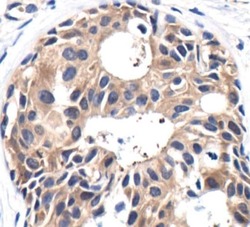
- Experimental details
- Immunohistochemical analysis of PP2A C Subunit in paraffin-embedded human breast carcinoma using a PP2A C Subunit polyclonal antibody (Product # PA5-17510) showing cytoplasmic localization.
Supportive validation
- Submitted by
- Invitrogen Antibodies (provider)
- Main image
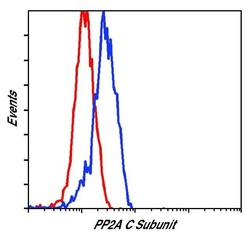
- Experimental details
- Flow cytometric analysis of PP2A C Subunit in NIH/3T3 cells using a PP2A C Subunit polyclonal antibody (Product # PA5-17510) (blue) compared to a non-specifc negative control antibody (red).
Supportive validation
- Submitted by
- Invitrogen Antibodies (provider)
- Main image
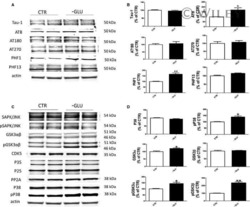
- Experimental details
- NULL
- Submitted by
- Invitrogen Antibodies (provider)
- Main image
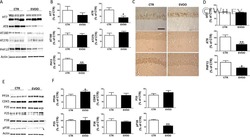
- Experimental details
- NULL
- Submitted by
- Invitrogen Antibodies (provider)
- Main image
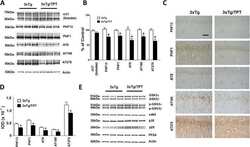
- Experimental details
- Fig. 4 Pharmacological chaperone reduces tau phosphorylation in 3xTg mice. a Representative Western blots of total soluble tau (HT7), and phosphorylated tau at residues Ser396 (PHF13), Ser396/Ser404 (PHF1), Ser202/Thr205 (AT8), Thr231/Ser235 (AT180), and Thr181 (AT270) in brain cortex homogenates from 3xTg mice treated with TPT (3xTg/TPT) or control (3xTg). b Densitometric analyses of the immunoreactivities to the antibodies shown in the previous panel. Values represent mean +- standard error of the mean (* p < 0.05, n = 3). c Representative immuno-histochemical staining images for PHF13, PHF1, AT8, AT180 and AT270 positive areas in brain hippocampus sections of 3xTg mice treated with TPT or control (scale bar: 100 mum). d Quantification of the integrated optical density (IOD) for the immunoreactivity to the same antibody shown in panel C. Values represent mean +- standard error of the mean (* p < 0.05, n = 4). e Representative western blots of GSK3alpha, GSK3beta, p-GSK-3alpha, p-GSK-3beta, cdk5, p35, p25, and PP2A in brain cortex homogenates from 3xTg mice treated with TPT or control (Ctrl) (n = 4 per group)
- Submitted by
- Invitrogen Antibodies (provider)
- Main image
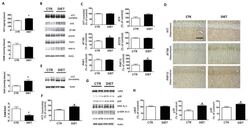
- Experimental details
- Figure 2 Diet-induced HHcy in brain affects tau phosphorylation and pathology A. Brain cortex homogenates from h-tau mice receiving the low folate and B vitamins diet (DIET) or chow diet controls (CTR) from 4 to 12 months of age were assayed by HPLC for levels of Hcy, SAM, SAH, and the ratio SAM/SAH calculated (*p
- Submitted by
- Invitrogen Antibodies (provider)
- Main image
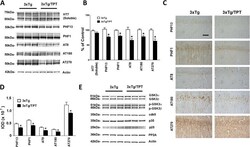
- Experimental details
- Fig. 4 Pharmacological chaperone reduces tau phosphorylation in 3xTg mice. a Representative Western blots of total soluble tau (HT7), and phosphorylated tau at residues Ser396 (PHF13), Ser396/Ser404 (PHF1), Ser202/Thr205 (AT8), Thr231/Ser235 (AT180), and Thr181 (AT270) in brain cortex homogenates from 3xTg mice treated with TPT (3xTg/TPT) or control (3xTg). b Densitometric analyses of the immunoreactivities to the antibodies shown in the previous panel. Values represent mean +- standard error of the mean (* p < 0.05, n = 3). c Representative immuno-histochemical staining images for PHF13, PHF1, AT8, AT180 and AT270 positive areas in brain hippocampus sections of 3xTg mice treated with TPT or control (scale bar: 100 mum). d Quantification of the integrated optical density (IOD) for the immunoreactivity to the same antibody shown in panel C. Values represent mean +- standard error of the mean (* p < 0.05, n = 4). e Representative western blots of GSK3alpha, GSK3beta, p-GSK-3alpha, p-GSK-3beta, cdk5, p35, p25, and PP2A in brain cortex homogenates from 3xTg mice treated with TPT or control (Ctrl) (n = 4 per group)
 Explore
Explore Validate
Validate Learn
Learn Western blot
Western blot Immunoprecipitation
Immunoprecipitation Immunohistochemistry
Immunohistochemistry